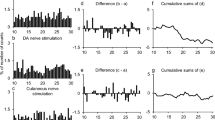Abstract
In pentobarbitone-anaesthetised spinal cats, a comparison was made of the effects of intravenous bicuculline hydrochloride, a GABAA-receptor antagonist, and several (-)-baclofen (GABAB-receptor) antagonists (CGP 35348, 46381, 56999A) on the prolonged inhibition of extensor-muscle monosynaptic reflexes, recorded from lumbar ventral roots, by brief or continuous tetanic stimulation of low-threshold afferent fibres of hindlimb flexor muscles. Two components of brief tetanus inhibition were detected. Whilst possibly of similar central latency, the inhibition associated with GABAB receptors had a longer time course than that reduced by bicuculline. Furthermore, whereas bicuculline reduced primary afferent depolarization, generated by the inhibitory volleys, and detected as dorsal-root potentials, such potentials were generally enhanced by intravenous baclofen antagonists. The inhibition of reflexes during and after continuous (333 Hz) tetanic flexor-nerve stimulation appeared to be predominantly associated with the activation of GABAB receptors. In the period following continuous tetanic flexor-nerve stimulation, during which monosynaptic extensor reflexes were reduced in amplitude, the action potentials of the intraspinal terminations of extensor-muscle group-Ia afferent fibres were reduced in duration, as detected by the time course of the recovery of the threshold to extracellular microstimulation following the arrival of an orthodromic impulse. A reduction in termination action-potential duration also accompanied the reduction by microelectrophoretic (-)-baclofen of the release of excitatory transmitter from group-Ia terminations, both presynaptic effects being blocked by microelectrophoretic baclofen antagonists. However, the reduction of the duration of the action potential of individual group-Ia terminations, which followed continuous flexor-nerve stimulation, was not sensitive to the baclofen antagonist CGP 55845A, but was diminished by bicuculline methochloride. Intravenously administered bicuculline hydrochloride, however, had little or no effect on the inhibition of reflexes following continuous flexor-nerve stimulation. These observations are discussed in the context of possible intraspinal pathways and pre- and postsynaptic mechanisms for GABAA and GABAB receptor-mediated inhibition of the monosynaptic excitation of spinal motoneurones and of the functional significance of central GABAB receptor-associated inhibitory processes, given the relatively minimal effects on motor activity and behaviour produced by baclofen antagonists that penetrate the mammalian blood-brain barrier.
Similar content being viewed by others
Author information
Authors and Affiliations
Additional information
Received: 2 July 1997 / Accepted: 30 January 1998
Rights and permissions
About this article
Cite this article
Curtis, D., Lacey, G. Prolonged GABAB receptor-mediated synaptic inhibition in the cat spinal cord: an in vivo study. Exp Brain Res 121, 319–333 (1998). https://doi.org/10.1007/s002210050465
Issue Date:
DOI: https://doi.org/10.1007/s002210050465



